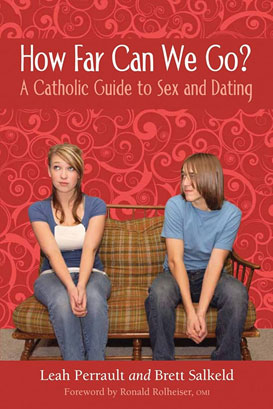September 23, 2025
Lately, I've noticed that many young Catholics in relationships often come to me with a straightforward question: “How far can we go?” This question goes beyond just physical limits; it’s really about how to express love in a way that stays true to our faith in Christ.
This prompted me to dig deep for a thoughtful and sincere answer. While reading “How Far Can We Go? A Catholic Guide to Sex and Dating” by Leah Perrault and Brett Salkeld, I discovered a wealth of clarity and insight. The authors tackle this delicate topic with a blend of realism, compassion, and a strong foundation in our Catholic beliefs.

Asking the Right Question
A lot of young people wonder, “How far is too far?” This book flips the script: rather than focusing on limits and loopholes, it encourages us to ask, “How can we love authentically?” The Church’s teachings aren’t about suffocating desire; they’re about channeling that desire toward genuine love.
What is Love, Really?
Love isn’t just about attraction or feelings—it’s about wanting what’s best for the other person. True love is grounded in selflessness, not selfishness. Lust may be disguised as love, but it seeks fulfillment at the cost of the other’s dignity. Christian love mirrors Christ’s self-giving love on the Cross.
Sex and the Meaning of the Body
Sex is more than just a physical act; it’s symbolic, expressing total self-giving. The Theology of the Body teaches that our bodies communicate a “language,” and sex is meant to convey, “I give myself to you completely and forever.” Outside of marriage, that promise of lasting commitment and openness to life is missing, which makes sexual intimacy feel dishonest.
Chastity: Freedom for Love
Chastity isn’t about denying pleasure; it’s about embracing authentic love. It weaves sexuality into the fabric of a person’s entire life. It offers true freedom—the ability to love without using others. Chastity (whether for the married or single) is what truly matters.
Desire, Temptation, and Boundaries
Desire is a good thing—it leads us toward love—but it needs direction. Boundaries are essential, not because sex is bad, but because it’s powerful and sacred. Couples should be honest with themselves about situations, environments, or actions that might jeopardize their commitment to chastity. A practical tip: steer clear of “how close can we get” scenarios; instead, focus on honoring each other’s dignity.
Dating as Discernment
Dating is more than just having fun or filling up time; it’s really about figuring things out. Each relationship teaches us how to give and receive love in different ways. Breakups can hurt, but they often lead us to discover what we’re truly meant to do. The aim isn’t solely to get married, but to grow in love and virtue along the way.
Sin, Guilt and God's Mercy
When it comes to sin, guilt, and God’s mercy, it’s important to recognize that everyone struggles with chastity—that’s just part of being human. Guilt can either weigh us down or help us find our way back to God. The sacrament of Reconciliation is there to restore us, heal our shame, and give us the strength to start fresh. Remember God’s love is greater than any mistake we make.
Growing together in Virtue
In relationships, both partners need to be dedicated to growing together. Prayer, open communication, and a supportive community are what really strengthen love. Love is a journey, not just a one-time choice. True intimacy develops when couples encourage each other to draw closer to God.
Toward the fullness of love
As the book wraps up, it encourages us to shift our perspective: instead of asking, “How far can we go?” let’s ask, “How far can we grow in loving like Christ?” Real love is patient, self-giving, and life-giving, ultimately guiding us toward God. The teachings of the Church aren’t meant to restrict us; they’re meant to free us, leading us to the deepest happiness and connection. This book is less about setting strict boundaries and more about nurturing our hearts to love as Christ does—freely, faithfully, fruitfully, and fully.